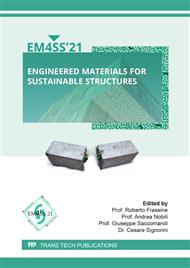[1]
European Environment Agency. Construction and demolition waste: challenges and opportunities in a circular economy, available at: https://www.eea.europa.eu/themes/waste/waste-management/construction-and-demolition-waste-challenges/download.pdf.static (2020), PDF TH-AM-19-016-EN-N - ISBN 978-92-9480-202-6 - ISSN 2467-3196 -.
DOI: 10.1163/9789004322714_cclc_2020-0201-1122
Google Scholar
[2]
Directive 2008/98/EC of the European Parliament and of the Council of 19 November 2008 on waste and repealing certain directive, available at: https://eur-lex.europa.eu/legal-content/EN/TXT/PDF/?uri=CELEX:32008L0098&from=EN. Last accessed: 31/01/(2021).
DOI: 10.1007/978-1-137-54482-7_45
Google Scholar
[3]
Y. Yu, D. M. Y, S. Bhochhibhoya, L. V, Towards Circular Economy through Industrial Symbiosis in the Dutch construction industry: A case of recycled concrete aggregates, J. Clean. Prod. 293 (2021) 126083.
DOI: 10.1016/j.jclepro.2021.126083
Google Scholar
[4]
R. V. Silva, J. De Brito, R. K. Dhir, Availability and processing of recycled aggregates within the construction and demolition supply chain: a review, Journal of Cleaner Production 143 (2017) 598-614.
DOI: 10.1016/j.jclepro.2016.12.070
Google Scholar
[5]
P. Rambelli, I materiali inerti riciclati: sostenibilità del riciclaggio e qualità, Degree Thesis, Alma Mater Studiorum e Università di Bologna.
DOI: 10.19103/as.2022.0112.11
Google Scholar
[6]
P. Ghisellini, M. Ripa, S. Ulgiati, Exploring environmental and economic costs and benefits of a circular economy approach to the construction and demolition sector. A literature review, Journal of Cleaner Production 178 (2018) 618-643.
DOI: 10.1016/j.jclepro.2017.11.207
Google Scholar
[7]
L. O. Oydele, S. O. Ajayi, K. O. Kadiri, Use of recycled products in UK construction industry: an empirical investigation into critical impediments and strategies for improvement, Resource. Conserv. Recycl. 93 (2014) 23-31.
DOI: 10.1016/j.resconrec.2014.09.011
Google Scholar
[8]
RINA, CE Marking of construction products, available at: https://www.rina.org/en/ce-marking-of-construction-products. Last accessed: 31/01/(2021).
Google Scholar
[9]
Remade in Italy, Certification scheme for the verification of the content of material recovered in a product, available at: https://www.remadeinitaly.it/recycled-products-certification/. Last accessed: 31/01/(2021).
Google Scholar
[10]
D. R. Vieira, J. L. Calmon, F. Z. Coelho, Life cycle assessment (LCA) applied to the manufacturing of common and ecological concrete: a review, Construct. Build. Mater. 124 (2016) 656-666.
DOI: 10.1016/j.conbuildmat.2016.07.125
Google Scholar
[11]
T. Blankendaal, P. Schuur, H. Voordijk, Reducing the environmental impact of concrete and asphalt: a scenario approach, J. Clean. Prod. 66, (2014) 27-36.
DOI: 10.1016/j.jclepro.2013.10.012
Google Scholar
[12]
M. Buyle, J. Braet, A. Audenaert, A, Life cycle assessment in the construction sector: a review, Renew. Sustain. Energy Rev. 26 (2013) 379-388.
DOI: 10.1016/j.rser.2013.05.001
Google Scholar
[13]
R. M. Cuellar-Franca and Azapagic, A. Azapagic, A, Environmental impacts of the UK residential sector: life cycle assessment of houses, Build. Environ. 54 (2012) 86-99.
DOI: 10.1016/j.buildenv.2012.02.005
Google Scholar
[14]
G. A. Blengini, Life cycle of buildings, demolition and recycling potential: a case study in Turin, Italy, Build. Environ. 44 (2009) 319-330.
DOI: 10.1016/j.buildenv.2008.03.007
Google Scholar
[15]
F. Ardente, G. Beccali, M. Cellura, M. Fontana, S. Longo, L'analisi del ciclo di vita applicata agli edifice residenziali: il caso studio di un edificio monofamiliare, La Termotecnica (2009) (in Italian) 55-59.
Google Scholar
[16]
L. A. Lopez-Ruiz, X. Roca, X., S. Gassò, The circular economy in the construction and demolition sector - a reveiw and an integrative approach, J. Clean. Prod. 248 (2020) 119-238.
Google Scholar
[17]
C. G. Da Rocha, M. A. Sattler, A discussion on the reuse of building components in Brazil: an analysis of major social, economic and legal factors, Resour. Conserv. Recycl. 54 (2009) 104-112.
DOI: 10.1016/j.resconrec.2009.07.004
Google Scholar
[18]
D. Bianchi, Il riciclo ecoefficiente, Edizioni Ambiente, Milano (2008).
Google Scholar
[19]
A. Coelho, J. De Brito, Influence on construction and demolition waste management on the environmental impact of buildings, Waste Manag. 32 (2012) 532-541.
DOI: 10.1016/j.wasman.2011.11.011
Google Scholar
[20]
L. C. M. Eberart, H. Birgisdottir, M. Birkved, Potential of circular economy in sustainable buildings, IOP Conf. Ser. Mater. Sci. Eng. 471 (2019) 092051.
DOI: 10.1088/1757-899x/471/9/092051
Google Scholar
[21]
Ellen Mac Arthur Foundation, Cities and the circular economy, available at: https://www.ellenmacarthurfoundation.org/explore/cities-and-the-circulareconomy. Last accessed: 27/07/(2021).
Google Scholar
[22]
B. Sanchez, B., C. Rausch, C. Haas, R. Saari, A selective disassembly multiobjective optimization approach for adaptive reuse of building components. Resour. Conserv. Recycl. 154, (2020) 104605.
DOI: 10.1016/j.resconrec.2019.104605
Google Scholar
[23]
V. Selicati, N. Cardinale, M. Dassist, Evaluation of the sustainability of energy retrofit interventions on the historical heritage: a case study in the city of matera, Italy. Int. J. Heat Technol. 38 (1) (2020) 17-27.
DOI: 10.18280/ijht.380103
Google Scholar
[24]
T. Wastling, F. Charnley, M. Moreno, M, Design for circular behaviour: considering users in a circular economy. Sustainability 10 (1743) (2018) 1-22.
DOI: 10.3390/su10061743
Google Scholar
[25]
D. Pearlmutter, D. Theochari, T. Nehls, P. Pinho, P. Piro, A. Korolova, S. Papaefthimiou, M.Carmen Garcia Mateo, C. Calheiros, I. Zluwa, U. Pitha, P. Schosseler, Y. Florentin, S. Ouannou, E. Gal, A. Aicher, K. Arnold, E. Igondová and B. Pucher, Enhancing the circular economy with nature-based solutions in the built urban environment: green building materials, systems and sites, Blue-Green Systems (2) 1, (2021) 47-71.
DOI: 10.2166/bgs.2019.928
Google Scholar
[26]
M. R. Munaro, S. F. Tavares, Materials passport's review: challenges and opportunities toward a circular economy building sector, Built Environment Project and Asset Management (2021) DOI 10.1108/BEPAM-02-2020-0027.
DOI: 10.1108/bepam-02-2020-0027
Google Scholar
[27]
F. Heisel, S. Rau-Oberhuber, Calculation and evaluation of circularity indicators for the built environment using the case studies of UMAR and Madaster, J. Clean. Prod. 243 (2020)118482.
DOI: 10.1016/j.jclepro.2019.118482
Google Scholar
[28]
T. Rau, S. Oberhuber, Material Matters, Edizioni Ambiente, Milano, (2018).
Google Scholar
[29]
S. Cristiano, P. Ghisellini, G. D'Ambrosio, J. Xue, A. Nesticò, F. Gonella, S. Ulgiati, Construction and demolition waste in the Metropolitan City of Naples, Italy: State of the art, circular design, and sustainable planning opportunities, J. Clean. Prod. 293 (2021) 125856.
DOI: 10.1016/j.jclepro.2021.125856
Google Scholar
[30]
Legambiente, Rapporto dell'Osservatorio Recycle – Legambiente, available at: https://www.legambiente.it/sites/default/files/docs/cento_materiali_rapporto_osservatorio_recycle.pdf. Last accessed: 28/07/(2021).
Google Scholar


